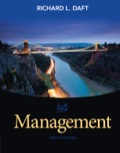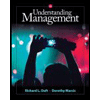
To determine:
The difference in planning today's organization as compare to planning 25 years ago.
Introduction:
Planning is a process of making the plan before executing any work. The process of planning includes identification of goals and objectives, formulation of strategies, creating the means required and implementation and monitoring.
The First step of planning is to establish a strategic goal. The strategic goal is a statement defining where the company wants to be in the future. The strategic goal represents the whole organization's goal rather than to the goal of a division or department. After setting the strategic goal, the organization prepares its strategic plans. Strategic plans define the action steps by which the company intends to attain strategic goals. Strategic plans are actually the blueprint that defines the organizational activities and allocations required for meeting long terms targets.
Trending nowThis is a popular solution!

- Can you guys help me on this? Thank you! Here's the authentic insight my classmate wrote about the article they chose. Please give a little comment on this insight that my classmate just wrote. Thank you!arrow_forwardHi! Can you guys help me with this? Thank you! Here's the article by Mark Chediak & Jennifer A Dlouhy from Bloomberg called US Imposes Tariffs Up to 3,521% on Southeast Asia Solar Imports Please offer authentic insights on how this article connects with global supply chain management.arrow_forwardHow an individual attending a university can help the development of a country?arrow_forward
- Discuss how personal ethical values, such as those held by Jane Harris, and corporate ethical values can influence business decisions at GlobalTech. Provide examples from the scenario where conflicts between personal and corporate ethics versus local business practices arise. - Provides a clear definition of personal and corporate ethical values and their relevance to business decision-making.- Discusses how Jane Harris's belief in ethical universalism influences her decision- making. Examples from the scenario are well integrated. - Explains the role of corporate ethics at GlobalTech, particularly around sustainability, fair wages, and safe working conditions. Discusses how these values shape business policies and practices. - Summarises the influence of personal and corporate values on decision-making and how ethical conflicts may affect a multinational business like GlobalTech. - The discussion is logically structured, with clear argumentation and a coherent flow of ideas.arrow_forwardYou will explain what it is, Benefits, Threats, and Ethical Challenges.arrow_forwardExplore strategies entrepreneurs and business leaders can use to balance ethical relativism and universal ethical principles when operating across diverse cultural landscapes, as illustrated by GlobalTech’s expansion into a developingcountry. -Provides a clear explanation of ethical relativism and universal ethical principles and why they are important in cross-cultural business operations. - Identifies and thoroughly explains at least three strategies to balance these ethical approaches. Application of examples from the scenario is key, especially in balancing cost savings with ethical standards. - Examines the challenges faced by GlobalTech and similar businesses in aligning local practices with global ethicalstandards, highlighting possible outcomes of choosing one ethical stance over another.arrow_forward
- tesla ebike new extended brand content: conclusion?arrow_forwardcontent:Overview of Apple Health as a Brand Extension?arrow_forwardI am designing a Management by Objectives (MBO) performance appraisal for the Training and Development Specialist position to be used I meet with the incumbent employee to explain your expectations for their performance over the next twelve months. I need 3 objectives that the employee will be evaluated on. Be sure to include the time line by which each goal will be met, as well as dates for review of accomplishments.arrow_forward
- Terminating an employee is often one of the most stressful, and in some cases, fearful decisions managers are required to take. After you read and understand the four bases (reasons) for terminating an employee on page 324 of your textbook you are to develop a short scenario as to why you have chosen an employee to be terminated. Following the scenario you are to prepare a step-by-step process for meeting with the employee being terminated. The process should be direct, without too much information that will cause a potential argument, but with enough information that provides background and future steps (last day of work, summary of benefits, if any, and expectations regarding employee behavior if the employee is returning to their work area until the actual termination date, rarely if ever the termination is due to insubordination). It should be assumed that you will have a fellow supervisor/manager or an HR professional in the termination discussion (terminations should never be…arrow_forwarduk unileaver stock exchange london , content: "abstruct"?arrow_forwardExplain how you can conduct rapid assessment in an area after the onset of an emergencyarrow_forward
 Understanding Management (MindTap Course List)ManagementISBN:9781305502215Author:Richard L. Daft, Dorothy MarcicPublisher:Cengage Learning
Understanding Management (MindTap Course List)ManagementISBN:9781305502215Author:Richard L. Daft, Dorothy MarcicPublisher:Cengage Learning Management, Loose-Leaf VersionManagementISBN:9781305969308Author:Richard L. DaftPublisher:South-Western College Pub
Management, Loose-Leaf VersionManagementISBN:9781305969308Author:Richard L. DaftPublisher:South-Western College Pub Contemporary MarketingMarketingISBN:9780357033777Author:Louis E. Boone, David L. KurtzPublisher:Cengage Learning
Contemporary MarketingMarketingISBN:9780357033777Author:Louis E. Boone, David L. KurtzPublisher:Cengage Learning




